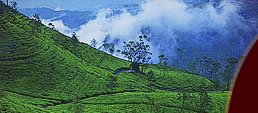| Tea bushes
on slopes are a familiar part of the Sri Lankan landscape.
Over 221,000 hectares or approximately 4% of the country’s
land area is covered in tea. Growing best at high altitudes
of over 2100 m, these plants require an annual rainfall
of more than 100-125 cm.
Tea is cultivated in Sri Lanka using the ‘contour
planting’ method, where tea bushes are planted
in lines, which follow the contours of the land. Young
tea plants are frequently cut back 10-15 cm from the
ground to encourage lateral growth. The plants are pruned
regularly to prevent them from becoming trees, and the
resultant bushes are flat topped and about 1m in height.
Pruning methods vary within the country, but the procedure
is always a skilful operation, performed with a sharp,
specially shaped knife as the tea bush should in no
way be damaged during the process.
Nurturing the tea bushes and treating the soil in which
they grow are an integral part of tea cultivation. Regular
application of fertiliser ensures healthy leaf growth.
For commercial manufacture the ‘flush’
or leaf growth on the side branches and stems of the
bush are used. Generally two leaves and a bud are plucked
- a skilful operation carried out in Sri Lanka by women.
Over the years female workers have acquired the ability
to quickly pluck the leaves, which are then transferred
to baskets carried on their backs. A tea plucker usually
aims for a daily target of 15 to 20 kg of tea leaves.
The plucked tea is then weighed and transported to the
nearby tea factory with as little delay as possible.
|



